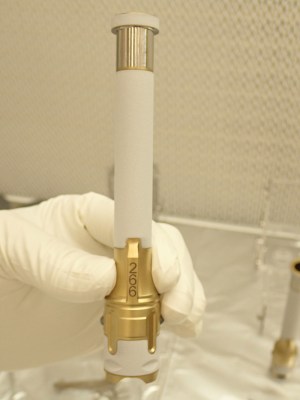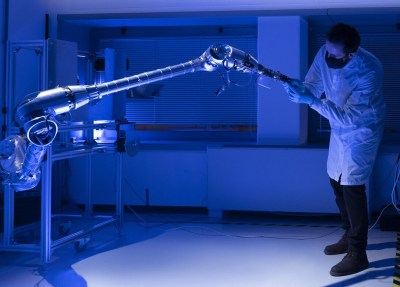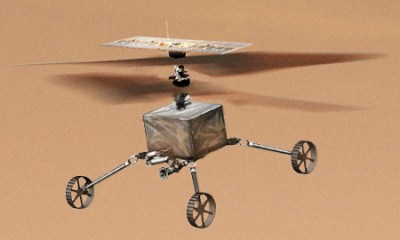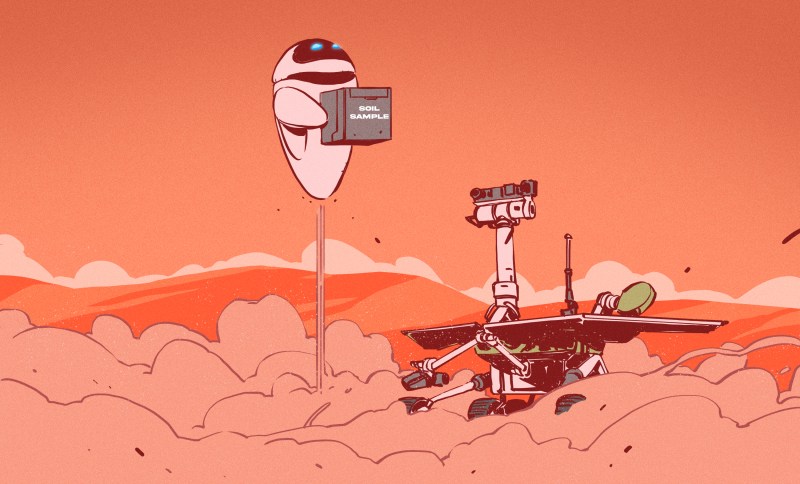For as long as humans have been sending probes to Mars, there’s been a desire to return rock, soil, and atmosphere samples back to Earth for more detailed analysis. But the physics of such a mission are particularly demanding — a vehicle that could land on the Martian surface, collect samples, and then launch itself back into orbit for the return to Earth would be massive and prohibitively expensive with our current technology.

Instead, NASA and their international partners have been working to distribute the cost and complexity of the mission among several different vehicles. In fact, the first phase of the program is well underway.
The Perseverance rover has been collecting samples and storing them in 15 cm (6 inch) titanium tubes since it landed on the Red Planet in February of 2021. Considerable progress has also been made on the Mars Ascent Vehicle (MAV) which will carry the samples from the surface and into orbit around the planet, where they will eventually be picked up by yet another vehicle which will ultimately return them to Earth.
But there’s still some large gaps in the overall plan. Chief among them is how the samples are to be transferred into the MAV. Previously, the European Space Agency (ESA) was to contribute a small “fetch rover” which would collect the sample tubes dropped by Perseverance and bring them to the MAV launch site.
But in a recent press release, NASA has announced that those plans have changed significantly, thanks at least in part to the incredible success of the agency’s current Mars missions.
Reliable Rovers
Originally, the NASA-built Sample Retrieval Lander (SRL) was to have delivered both the MAV and the ESA’s rover to the surface in one shot. But in 2020 an Independent Review Board expressed concern with the size and mass of such a vehicle, specifically that it would necessitate the development of a new and therefore untested Entry, Descent and Landing (EDL) system. They argued that the MAV and ESA rover should land separately using a variation of the EDL technology developed for the Curiosity and Perseverance rovers.
Instead, NASA and the ESA have agreed to simply delete the rover entirely and have Perseverance deliver the samples to the SRL itself. Based on the longevity of Curiosity, which has now spent a decade on the Martian surface, there’s an excellent chance that Perseverance will still be operational in 2031 when the SRL is expected to arrive.

From an outsider’s perspective, it might seem like this should have been the plan from the start. After all, if the samples are already on a functioning rover, why do you need a second rover to come retrieve them? But keep in mind that when this plan was originally devised, Curiosity and its twin Perseverance had yet to prove themselves. Having the smaller and less complex ESA fetch rover available was seen as a reasonable precaution, so that the samples could be retrieved even if Perseverance itself had failed or became stuck.
But there’s something of a catch. The robotic arm on Perseverance which handles the sample tubes lacks the necessary dexterity to actually load them into the MAV. The best it will be able to do is drop them on the surface close enough to the SRL that its ESA-developed 2.5 meter (8.2 feet) Sample Transfer Arm can pick them up and store them. It won’t be the most glamorous of hand-offs in the history of interplanetary exploration, but there’s something to be said for keeping things simple.
Helicopter Backup
While the new plan utilizes Perseverance as the primary means of sample transportation, the success of the overall mission is too important not to build some redundancy into the plan. So in place of a second rover, NASA has decided to go with a bold approach that would have been considered science fiction just a few years ago: should Perseverance be unable to reach the SRL for whatever reason, a pair of helicopters derived from the design of the wildly successful Ingenuity will attempt to retrieve them.

Little information has been released about how these new helicopters will differ from their predecessor, other than the fact that they will now feature wheels mounted to the end of the landing legs and a miniature robotic arm capable of capturing a single sample tube. The addition of wheels means that the helicopters don’t need to land directly over the tube, they just need to get close enough that they can roll over to them. After the sample tube has been picked up from the surface, the helicopter will fly it back and drop it by the SRL.
While Ingenuity has far exceeded all expectations in terms of its performance and longevity, the proposed modifications to the aircraft and this ambitious new mission present new challenges and risks. Sending a pair of helicopters offers another layer of redundancy, and it’s likely that the second helicopter won’t even be activated until the first one has demonstrated its ability to retrieve a sample, offering mission controllers a valuable “do over” should something go wrong.
Of course, should Perseverance not need any help completing its mission, you can be sure that NASA will have some scientifically valuable task that the pair of choppers can set themselves to. After all, you don’t carry hardware 100 million miles to not use it.

















I sense a disconnect here with NASA. They are betting that in a couple of years Space-x’s Starship is going to be able to land men on the moon, but they are at the same time acting that it is going to be in-capable of landing on Mars carrying a substantial amount of payload before 2033.
Starship hasn’t successfully reached orbit yet.
Although I respect, admire, and enjoy watching the effort, I keep think of the Soviet N1 every time I look at the Starship booster. Getting something with 33 engines man-rated is going to take an awfully large number of flawless flights prior to that.
N1 might have worked if they weren’t threating to send the engineers to a gulag is they missed a launch date.
They blew up the first one welding on it while it was fueled and ready to go. There is video, it’s horrifying. More balls/vodka than brains.
That’s why you don’t take jobs with places that use Javascript on the server. Broken culture. You won’t be able to fix that.
“They blew up the first [N1] welding on it while it was fueled and ready to go.”
All four of the N1 flight vehicles got off the ground per the programmed launch sequences, albeit not very far. If you’re talking about a factory fire of some sort, you’ll need to provide a better hint.
1) There are significant differences between landing on the moon and landing on mars.
2) We’ve landed on the moon safely before (with ye olden technology) but never on Mars.
3) Starship is not being used for crew transport and is still in development for landing on the moon.
4) It’s an unproven technology as it’s has yet to demonstrate that it can safely land on anything.
5) Starship is so large that it would need to refuel on Mars and we don’t have a compact Mars-ready machine to manufacture methane from CO2.
6) NASA can change their plans again if Starship becomes and option.
A fleet of robotic cargo vessels that can drop intelligent fuel modules that can link up to power Starship or similar rocket ships might be a good starting point. They vessels could be reusable, recyclable, or disposable, but they don’t really need people for that kind of thing anymore. Also, why not a chain of fuel depots in space between here and there, designed so they can later be expanded to include comfort stations with such amenities as a coffee shop, convenience store, cocktail lounge, bakery, mosque, tanning salon, and clean restrooms?
…
What would NASA scientists do with 2 helicopters that have finished their mission?
Aerial combat!
“Welcome to Robot Wars, Season 2028! We are live reporting from mars with a slight delay of about 15minutes due to transmission…”
They could save millions by reusing an old GUI
https://m.youtube.com/watch?v=KJiVh9v9VFA&vl=en
Wow, that’s much better graphics than the original Apple II version that I played. Choplifter, along with Frogger are two classic computer games. Of course, Zork was fun for a while, too.
“fetch rover”?
More like a pooper scooper for rovers.
If Perseverance is going to carry the samples around until SRL arrives, what happens if Perseverance suddenly dies? Now you have no way of dropping off the samples for retrival. The original plan I believe was to drop off the samples one they had all been collected so even if something happened to the rover the samples would still be there waiting for pickup.
“If Perseverance is going to carry the samples around until SRL arrives”
It isn’t the sample caching strategy is to collect duplicate sample, carry some with the sample rover, and drop some off along the route. After sampling was complete, the carried sample tubes would have been dropped in a single or several slightly smaller caches for collection, or split between a cache and on-board storage so that if the fetch rover failed, the sample tubes on the sample rover could be carried back to the MAV.
Now, with the fetch rover no longer part of the CONOPS, those dropped sample tubes would be the contingency for collection by the fetch helicopters in the event the sample rover fails.
Sample caching strategies have been discussed since long before Perseverence was assembled, and the ‘fetch rover’ architecture has been far from the only one studied.
I was wondering about possibilities for aerial pickup, as trialled for army air co-operation and so on, e.g. snatching a line with a hook… but it seems aerodynamics on Mars ain’t very helpful, you’d need something like a Gossamer Albatross type construction to fly below 200mph and stay in the air.
A years-long thread on the whole “Mars Sample Return” system at unmannedspaceflight.com is worth reading for its very informed comments. This new helicopter system is discussed from page 30 on:
http://www.unmannedspaceflight.com/index.php?showtopic=2570&st=435
There’s some grumbling that Perserverance “will be way outside the warranty then”, plus the jump of making helicopters mission-critical instead of just a technology demonstrator.
But it seems the most concern is still with the unproven Mars-to-orbit rocket, MAV. The design is not yet frozen, but time is passing. While originally there were supposed to be many full-up flight tests of the system before send it to Mars, it may be they’ll just trust that component testing is enough and go for it “all-up”. There’s discussion about how risky that really is.
Getting a few grains of Mars dirt to Earth will require many complex steps no matter what is flown. Key quote:
“It still means that success would depend upon three successful launches from Earth, two [now one] successful landings on Mars, one successful Mars orbit injection, one successful launch from Mars, successful ground operations on Mars, successful rendezvous and transfer in Mars orbit, and one successful return to Earth. Ten successes in a row is a high standard to hit.”
I trust they are doing the right thing with this very risky Mars sample return mission, but another solution might be to land an advanced as possible immobile science lab and have a number of small rovers with no major analysis capabilities take samples which are flown back to the central lab lander.
hmm, two is not very many – trying to deal with payloads is going to be a more complex activity where things will go wrong. Need a swarm of helicopters – like a dozen
Perseverance retrieves ‘sticks’ it has left scattered around the place and drops them like a good dog at the feet of the MAV – can we anthropomorphise any better than that?